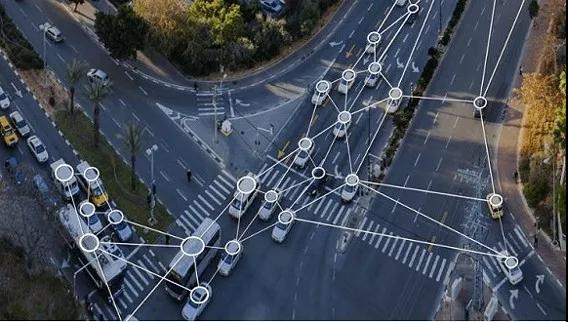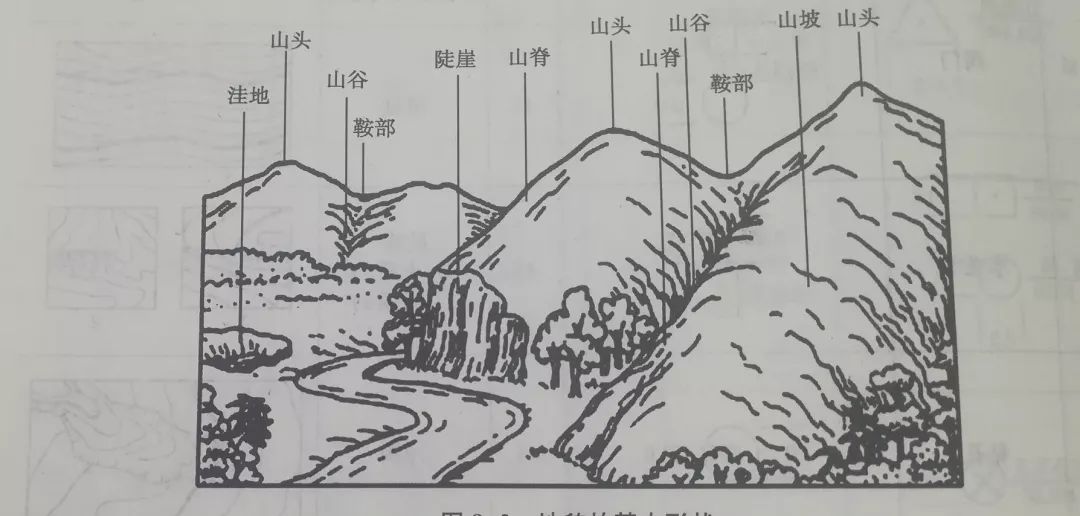Abstract:
The first two Medium Earth Orbit(MEO)satellites of the third generation of BeiDou satellite navigation System(BDS-3)were successfully launched on November 5,2017.This historical launch starts the new era of the global navigationsatellite system of BeiDou.Before the first two satellites of BDS-3,a demonstration system for BDS-3 with five satellites,including two Inclined Geosynchronous Orbit satellites(IGSO)and three MEO satellites,was established between 2015 and2016 for testing the new payloads,new designed signals and new techniques.In the demonstration system,the new S frequencysignal and satellite hydrogen clock as well as inter-satellite link(ISL)based on Ka-band signals with time-division multipleaddresses(TDMA)were tested.This paper mainly *** yzes the performances of the demonstration system,including the signal-to-noise ratios,pseudorange errors and the multipath errors of the civilian signals of BDS-3.The qualities of signals in space,time synchronization and timing precision were tested as well.Most of the performances were compared with those of theregional BeiDou satellite navigation system(BDS-2).At last,the performances of positioning,navigation and timing(PNT)ofthe future BeiDou global system(BDS-3)were eva luated based on the signal quality of the present demonstration satellitesystem.
Keywords :BeiDou-3,Demonstration satellite,Signal,Timing,Signal-to-noise ratios
01 Introduction
According to the three-step development strategy,BeiDousatellite navigation system has completed the BeiDou de-monstration system(1990−2003),simply called BDS-1,andthe regional BeiDou satellite navigation system(2003−2012),referred to as BDS-2.And now the BeiDou globalsatellite navigation system is under construction,which is aglobal service system and called BDS-3.

添加微信好友, 获取更多信息
复制微信号
The BDS-1 started its service from 2003,including posi-tioning,timing and short message communication(Yang,2010;Yang et al.,2011).BDS-1 provides services based ontwo geosynchronous orbit(GEO)satellites with additionalbackup satellite,using transparency retran *** ission mode.Asthe three dimensional(3-D)coordinates cannot be obtaineddirectly by just measuring the ranges from the receiver toonly two satellites,the measured ranges are first tran *** ittedto the ground control center,where the 3-D coordinates canbe calculated by mapping the ranges with the topographicmap,and then the control center tran *** its the coordinates back to the users by an encrypted satellite link.Apparently,this method needs to build a data channel between the usersand the control center to achieve a two-way communication,which provides a basis for achieving the location trackingservice and the short message communication service(Tan,2010;Gu et al.,2015).The positioning accuracy provided byBDS-1 can reach 20 m;the time accuracy is able to achieve100 ns with one-way timing method,and 20 ns with round-way timing method.The short message communicationservice has the capacity to tran *** it a message within 240bites.The BDS-1,however,cannot provide dynamic posi-tioning services.
The BDS-2 became operational in 2012(Yang et al.,2014).It consists of 5 GEO satellites,5 Inclined Geosyn-chronous Orbit(IGSO)satellites and 4 Medium Earth Orbit(MEO)satellites.And its service covers the area from 55°Sto 55°N latitude and 55°E to 180°E longitude,which covers94.6%of Asia-Pacific area.The system not only continuesthe service of positioning,timing and short message com-munication like BDS-1 does,but also provides kinematicpositioning.Furthermore,the BDS-2 significantly improvesthe positioning and timing accuracy.The whole constellationof BDS-2 broadcasts triple frequency signals B1,B2 and B3.Compared with dual-frequency signals,Triple frequencysignals can provide more combinations with excellent char-acteristics(Li J L et al.,2012,2017),speed up the carrierphase ambiguity resolution(Feng,2008;Geng and Bock,2014;Li J L et al.,2013),be beneficial for long distance RTKsolution(Li B F et al.,2017)and improve the accuracy andreliability of positioning(Li B F et al.,2013).
Since the BDS-2 provided its service,most of the perfor-mance indexes have been sufficiently verified,including theaccuracy of signal in space,performances of the satelliteorbit determination and satellite clock,the accuracy of po-sitioning and timing etc.The precision of BDS-2 B1 codeand carrier phase measurement are about 11 cm and 0.5 mmrespectively,and that of B2 code and carrier phase mea-surement are about 5 cm and 0.3 mm.And the single pointpositioning by using B1 code measurements can achieve 6 min the horizontal component and 10 m in the vertical com-ponent(Yang et al.,2014).The research towards the orbitdetermination of BDS-2 has been reported(He et al.,2013;Shi et al.,2012).In general,the radial accuracy of thebroadcast orbits is better than 0.5 m for IGSO and MEOsatellites,and 1.0 m for GEO satellites;and the orbit accu-racy of the precise ephemeris is better than 10.0 cm in theradial direction for IGSO and GEO satellites,and about50.0 cm for GEO satellites(Peng et al.,2016;Shi et al.,2012).During the satellite eclipse period,especially in theyaw-maneuver period,the orbit accuracies of IGSO andMEO satellites are degraded;the orbit error of the broadcastephemeris is about 1.5�C2.0 m in the radial component,butthat of the precise ephemeris can exceed 10.0 cm in the radial component(Peng et al.,2016).The differences between thesatellite precise clock offset products provided by the Bei-Dou *** ysis centers are usually about 0.5 to 0.8 ns for GEOsatellites,0.2 to 0.3 ns for IGSO satellites and 0.15 to 0.2 forMEO satellites(Guo et al.,2016).The frequency stability ofthe rubidian clock onboard of the BDS-2 satellites is about7×10−12�C1×10−11 at 1 second,1×10−13 at one thousand sec-onds and 2.53×10−14�C9.38×10−14 at one day(Han et al.,2013).The timing accuracy can achieve 50 ns in one-waytiming service and 10 ns in two-way timing service(Han etal.,2011).Also,the position accuracies for different posi-tioning modes of BDS-2 have also been researched(Shi etal.,2013;He et al.,2014;Li J L et al.,2017).
The global BDS(BDS-3)was started in 2016.It consists of3 GEO satellites,which will be located at 80°E,110.5°E and140°E,respectively;3 IGSO satellites with 55°orbit in-clinations,and 24 MEO satellites located in three orbitplanes with 21528 km altitude and 55°orbital inclinations.And the constellation will be fully operational by 2020(China Satellite Navigation Office,2017a).
On November 5,2017,the first two BDS-3 satellites werelaunched(SV number 19 and 20),which means that theChina BDS starts its global system construction.But beforethe launch of the first two BDS-3 satellites,a demonstrationsystem with five satellites,including two IGSO satellites,I1-S and I2-S,and three MEO satellites,M1-S,M2-S,and M3-S,had been established since 2015 to fully verify the designof the BDS-3.The demonstration system tran *** its signals onfour frequencies at 1575.420 MHz(B1),1191.795MHz(B2),1268.520MHz(B3)and 2492.028 MHz(Bs).The inter-sa-tellite link was built on the demonstration system based onthe Ka-band signals and the new hydrogen clock was em-ployed on one satellite.Based on the demonstration system,the synergy and coordination status among the satellites andthe control center,the inter-satellite links,and the uploadinginjection and downloading reception signal have been testedunder different conditions;and the quality of the receivingsignals has also been monitored and *** yzed.At the sametime,the performance of the BDS-3 precision orbit de-termination,positioning,velocity and timing(PVT)indexeshave also been validated and eva luated.Thus,the PNTperformance of the future BDS-3 has been comprehensivelytested and eva luated.
This paper is mainly designed to make a relatively com-prehensive eva luation of the performance of the BeiDouglobal navigation satellite system based on the data *** ysisof the BDS-3 demonstration system.In the second part,thefrequency design and satellites basic payloads of BDS-3 areintroduced.The third part mainly focuses on the *** ysis ofthe BDS-3 user application performances,including thesignal-to-noise ratio of each frequency signal,the precisionof the single frequency pseudorange measurement and usertiming accuracy,etc.At last,the possible performances of the global BDS-3 are predicted based on the tested signal qua-lities and the designed BDS-3 constellation.
02 The basic performance of the demonstration System
The BDS-3 not only has a significant improvement over theBDS-2 in terms of satellite constellation,but also has madegreat adjustments in many other aspects.In terms of satellitepayloads,new hydrogen atomic clock,inter-satellite link *** ased on the Ka-band signal,and the satellite antenna forbroadcasting S-band signals have been added to the BDS-3test satellite;in the aspect of signal design,BDS-3 also hasgreat improvement compared with BDS-2,see Table 1.Thenew designed signals of BDS-3 partly overlap with GPS,Galileo,QZSS and INSS,which is beneficial for improvingthe compatibility and interoperability among the differentsystems.As the L band radio frequencies are crowed in sa-tellite navigation,the new designed S-band signal,Bs,onBDS-3 will increase the frequency source for the future sa-tellite navigation system(Tan,2017).In addition,in order torealize the *** ooth transition from BDS-2 to BDS-3,thedemonstration satellite system not only tran *** its the newdesigned signals but also tran *** its the B1I and B3I/Q signalsof BDS-2.The satellite I1-S only tran *** its B1I and B3I/Qsignals of BDS-2,while the satellites I2-S,M1-S and M2-Stran *** it the new designed signals of BDS-3 and B1I andB3I/Q signals.The signal Bs is only tran *** itted by I2-S andM1-S satellites.The M3-S is only used for on-orbit testingand has not been officially put into use.

Table 1 Comparison of frequency distribution between BDS-3 and other satellite navigation system
The frequency stability of the atomic clock on the de-monstration system is about 10−14 at one day for the rubidiumatomic clock and about 10−15 at one day for the hydrogenclock,which is improved compared to the atomic clocks onthe BDS-2.The accuracy of time synchronization betweenthe satellites-ground,satellite-satellite,and station-station isabout 0.14 ns.The two hour prediction accuracy of satelliteclock error is about 0.4 ns,which is significantly improvedcompared with BDS-2(China Satellite Navigation Office,2017b).
The orbit accuracy of the multi-satellites overall orbit de-termination is better than 1.5 m.The user range predictionaccuracy in 2 hours is about 0.5 m.The joined orbit de-termination with satellite-ground and satellite-satellite ob-servations is about 1 m,and the prediction accuracy in 2hours is about 0.31 m,which is better than those determinedonly by satellite-ground observations(Chen et al.,2016;Tang et al.,2017).The accuracy along track(T component)of the orbit is greatly improved by 63.1%,and the accuracyof the orbit prediction is improved by 75.7%,due to theconstraints in the T and normal component(N)by ISL.Thejoint prediction of clock offset improves from 0.4 ns to 0.3 ns for IGSO satellites and from 1.1 to 0.5 ns for MEO satellites.The improvement reaches 53.9%compared to those de-termined only using satellite-ground link observations.Theautonomous orbit determination accuracy can achieve 6 mby using the inter-satellite link with support of the priormeter-level orbit determined by the control center using Lband(Ren et al.,2017).
The range accuracy for the monitoring receiver is about0.04 ns and for the multi-frequency receiver is 0.1�C0.4 m.The velocity accuracy is 0.03 m/s(95%).As we know thatthe demonstration system of BDS-3 cannot provide posi-tioning service in most cases due to not enough satellites.Bycombining BDS-2 and the demonstration satellites of BDS-3,we can get 3.5 to 4.3 m single frequency positioning ac-curacy in the horizontal components and 3.8 to 5.9 m in thevertical component(China Satellite Navigation Office,2017b).
03 Performance *** ysis of user’s monitoring
To verify the potential performance of the future global BDS,the performance in the users’side are *** yzed,the emphasisof which is on the prediction of the performance based on the *** yzed demonstration signal quality and the constellationgeometry of the BDS-3.
3.1 Analysis of signal-to-noise ratio
The satellite Signal-to-Noise Ratio(SNR)is an index of thesignal quality and related to the accuracy of the carrier phasemeasurement(Zhang and Ding,2013).The variations of theSNR with elevation angle of the test satellite signals arefirstly *** yzed in this paper.The experimental test is con-ducted in Zhengzhou area,China.The data are collectedbetween 20th and 26th Oct.2017 using the receiver producedby Chengdu Guoxing Company.The sampling rate is 30 s,and the cutoff elevation angle is set to 10°.With the SNRbeing averaged by every 2°elevation angle,Figure 1 showsthe SNR versus satellite elevation angle of the B1C,B1I,B2b,B2a+b,B3I and Bs signals on I2-S and M1-S satellites.(The SNR of B2a signal is not involved,due to the receiverproblems).
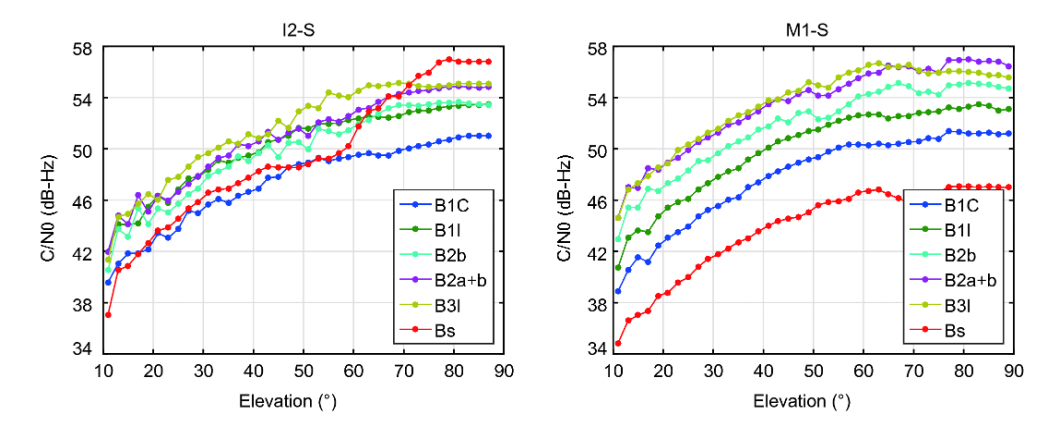
Figure 1 Measured signal-to-noise ratio versus elevation angle of BDS-3 test system satellites signals.
From Figure 1,we find that different signals have nearlythe same tendency of the SNR versus satellite elevation an-gle,which can be interpreted that the SNR increases as theelevation angle increases.It is also noted that the SNR ofMEO satellites is about 2�C3 dB larger than that of IGSO atthe same elevation angle,the reason of which may be that theIGSO satellites have higher altitude and less tran *** issionpower than those of MEO satellites.
The SNR versus satellite elevation angle of Bs signal,which is plotted by red-dot line,exhibits abnormal behavior,and it performs different between IGSO and MEO satellites.For I2-S satellites,the SNR of Bs signal changes sig-nificantly with the elevation angle.And it is *** aller thanthose of other signals at low elevation angle,but bigger athigh elevation angle,as it increases quickly as elevationangle increases.For M1-S satellite,the SNR of Bs signal is *** aller than those of other signals all the time,the reason ofwhich might be the lower tran *** ission power of M1-S,seeFigure 1.
3.2 Pseudorange noises *** ysis
Pseudorange noise is one of the basic performances that theusers are most concerned about,because that most of theusers can only afford low-cost single frequency navigationreceivers.The performance of the single frequency pseu-dorange noises is *** yzed based on the time-differencedcode minus phase(CC)combination(de Bakker et al.,2009).Time-differenced CC combination can eliminate the carrierphase ambiguity and weaken the ionospheric delay,hardwaredelay and multipath effect.The remaining error mainly re-flects the pseudorange noise.In our test,the time series of thetime-differenced CC combination are calculated for eachnavigation signal,and then the Root Mean Square(RMS)errors relative to zero mean are obtained in every 10°ele-vation angle interval.At last,the calculated RMS is trans-formed into the RMS of un-differenced pseudorange noisefor each navigation signal.Figure 2 shows the variations ofthe un-differenced pseudorange noise with satellite elevationangle of different signals on satellites I2-S and M1-S.It isobvious that all the frequency signal noises for both IGSOand MEO satellites change with the elevation angles.Andthe similar phenomenon is shown in the other two satellitesI1-S and M2-S,which is omitted in this paper.From Figure 2,we find that:
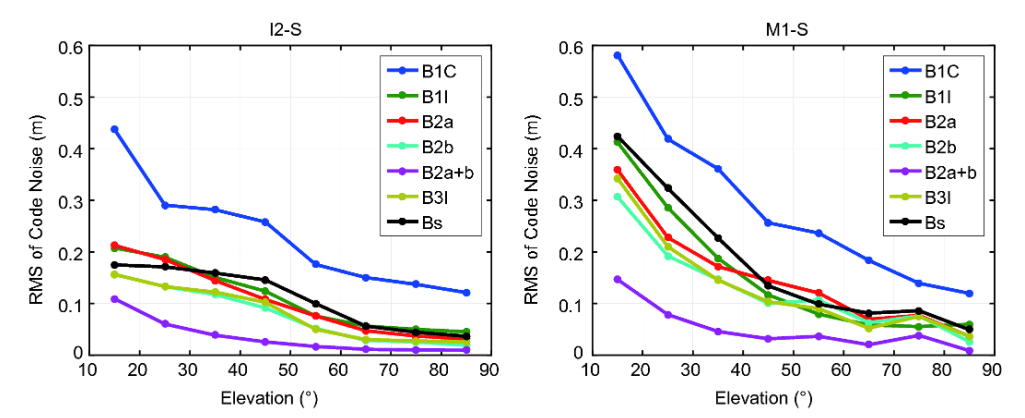
Figure 2 RMS of code noise versus elevation angle of BDS-3 test system satellites signals.
(1)The pseudorange noises of each frequency signal de-creases as the elevation angle increases,and tends to bestable when the elevation angle is greater than 50°.
(2)The RMS of B1C signal is higher than those of othersignals at the same elevation angle.The RMS of the pseu-dorange noises of B2a+b is the *** allest.
(3)By comparing the pseudorange noise within the sametype of satellite,IGSO and MEO,it can be noticed that thepseudorange measurement accuracy of the same signal issimilar among the same type of satellites.
(4)It should be noted that the RMS of the pseudorangenoise of MEO satellites is larger than that of IGSO satellites,and the reason may be that the ratio of low-elevation ob-servations of MEO satellites in the observation arc is morethan that of IGSO satellites.
(5)It can also be found that B1C signal has the worstpseudorange measurement accuracy among the signals whileB2a+b signal has the best;the pseudorange measurementaccuracy of Bs signal is worse than that of B2a+b,but betterthan that of the B1C signal.
3.3 Pseudorange multipath *** ysis
The multipath error affects the satellite orbit determinationand user’s positioning accuracy.Previous study has pointedout that there are systematic errors related to elevation angleexist in the pseudorange multipath of BDS-2 triple fre-quencies signals(Wanninger and Beer,2015).This kind ofsystematic errors may be caused by the satellite-inducedmultipath error and can influence the performance of posi-tioning.We use multipath combination(MP)to *** yze themultipath of the test satellites of BDS-3(de Bakker et al.,2009;Wanninger and Beer,2015).Figure 3 presents the timeseries of the multipath combination of BDS-3 signals of I2-Sand M1-S satellites,and Figure 4 shows the RMS of themultipath of different signals on I1-S,I2-S,M1-S and M2-Ssatellites.
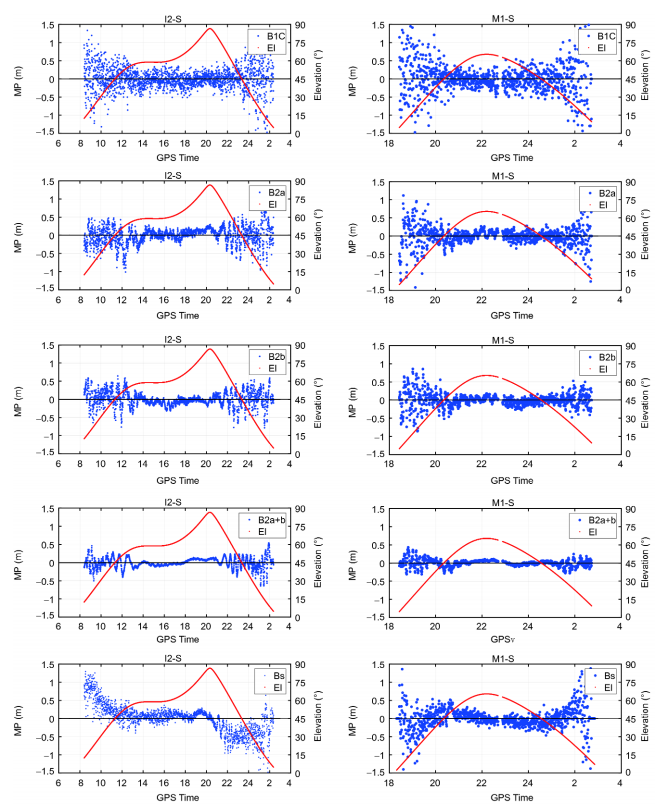
Figure 3 MP time series of BDS-3 new designed signals of 12-S and M1-S satellites.
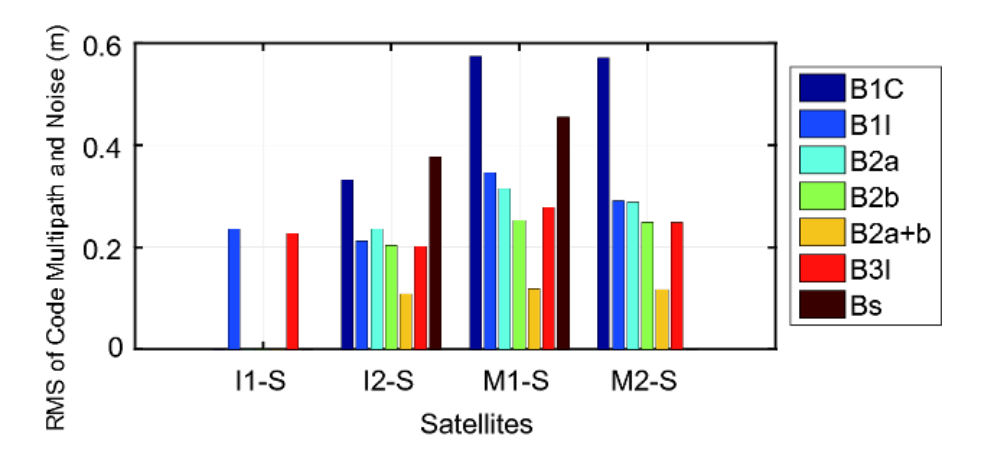
Figure 4 RMS of code multipath of testing satellites.
From the Figure 3 and 4,we find that:
(1)The pseudorange multipath effect of the BDS-3 globalsystem signal is obviously reduced,and there is almost noobvious systematic error that related to the elevation angle.
(2)Among the different signals,B2a+b signal has thestrongest anti-multipath ability,while the B1C has the worst.
(3)Unlike other signals,the multipath of Bs signal hassome systematic trends on IGSO and MEO satellites,asshown in Figure 3.This may be caused by the differencebetween the S frequency and L frequency antenna.
(4)The RMS of MEO multipath errors is larger than that ofIGSO satellite.In our opinion,this phenomenon is partlycaused by the large proportion of low-elevation observationsof MEO satellites during the observation period.
To compare the multipath effects of BDS-3 and BDS-2,wecalculated the multipath on B1I and B3I frequencies of MEOand IGSO satellites.The time series of the multipath of MEOsatellites are presented in Figure 5 and that of the IGSOsatellites are plotted in Figure 6;Figure 7 illustrates the RMSof the multipath errors on B1I and B3I signal of all IGSO andMEO satellites of BDS-2 and the BDS-3 demonstrationsystem.
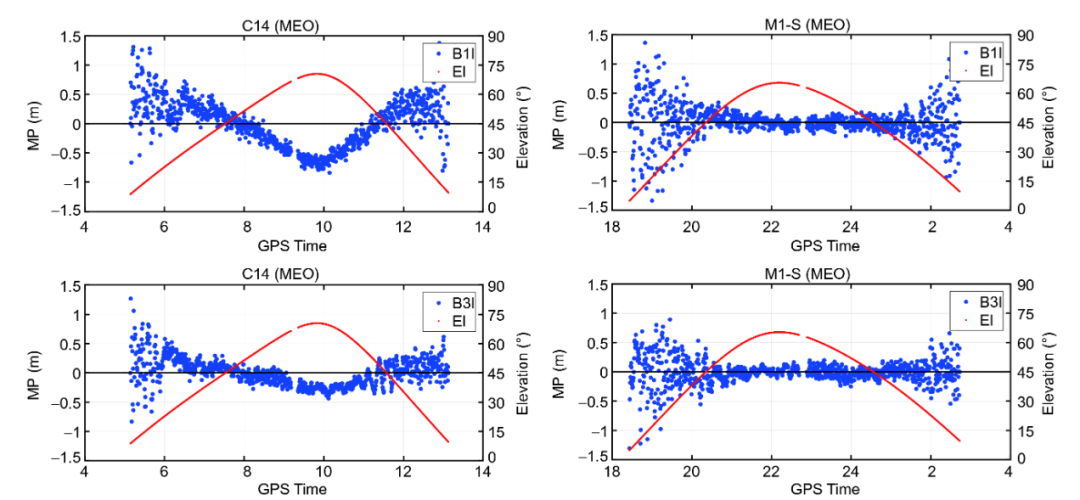
Figure 5 MP time series of BII and B3I signals of the MEO satellite of BDS-2 and the BDS-3 demonstration system. C14 represnts the MEO satellite of BDS-2. and M1-S represnts that of BDS-3.
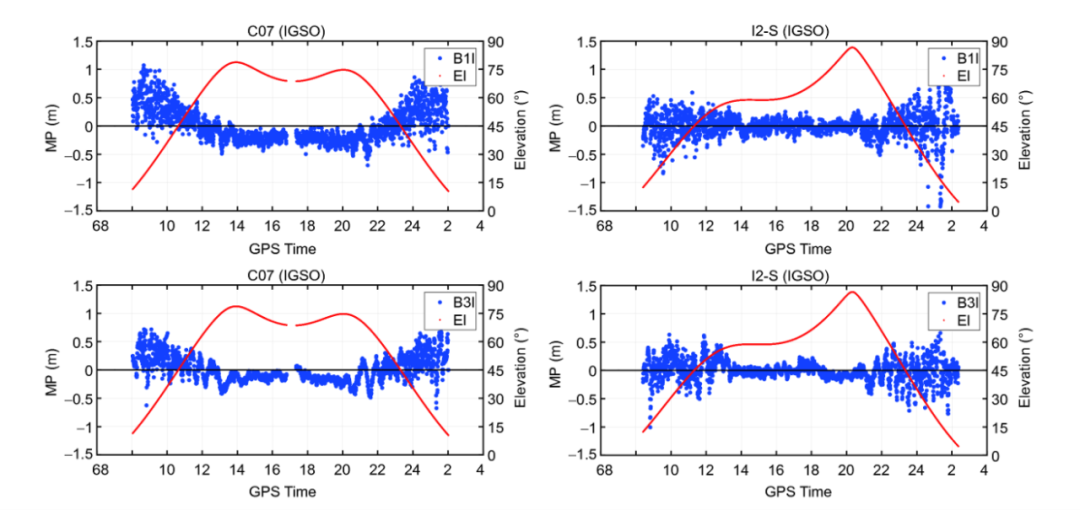
Figure 6 MP time series of BII and B3I signals of the IGSO satellite of BDS-2 and the BDS-3 demonstration system. C07 represnts the IGSO satellite of BDS-2, and 12-S represnts that of BDS-3.

Figure 7 RMS of code multipath of BII and B31 signals. Ci represnt satellites of BDS-2, and I or M represnt that of BDS-3.
From Figure 5,6 and 7,we can conclude that:
(1) The pseudorange multipath effect of B1I and B3Isignals on BDS-3 test satellites is less than that of BDS-2satellites,as there are systematic errors associated with ele-vation angles exist in the pseudorange multipath of BDS-2satellite.However,no obvious such systematic errors havebeen observed in the pseudorange multipath of BDS-3 testsatellites.
(2) In Figure 7,we find that the IGSO satellites,which areC06-C10 of BDS-2 and I1-S,I2-S of BDS-3,have lesspseudorange multipath errors than those of MEO satellites.(3)The pseudorange multipath of B3I signal is less thanthat of B1I signal.Therefore,the BeiDou ICD suggestedusing B3I signal as the reference of frequency bias.
3.4 Signal-in-space quality and timing accuracy
The User Equivalent Range Error(UERE)is often used torepresent the signal-in-space quality,and its quantity reflectsthe single point positioning accuracy(Montenbruck et al.,2015).The UERE could be calculated via,





In order to assess the signal-in-space quality of the testsatellites,we used a BDS-3 test terminal to monitor B1I andB3I signals of the four test satellites in Beijing from March 3to March 9,2017.In the experiment,UERE of B1I and B3Isignals of each test satellite are calculated according toFormula(1),and the daily average value of the corre-sponding UERE is derived.The statistical results are shownin Table 2.

Table 2 BDS-3 daily UERE of BDS-3 test satellites (Unit: m)

Table 3 Timing accuracy of BDS-3 test satellites (ns)a)
From the Table 2,we can find that the UERE of IGSOsatellites of BDS-3 is better than that of MEO satellites.Thereason may be that the MEO satellite has less observabletime and the observation ratio of the mid-and low-elevationangle in the satellite observation period is relatively large.In addition,Table 3 presents the timing accuracies of BDS-3 test satellites monitored by Beidou satellite operation andcontrol system using multi-frequency receiver and compa-tible receiver.Among them,the timing accuracy is calculatedby extracting time parameters from the user pseudorangeobservation equations.In the calculation,the user position isknown and fixed,the satellite orbit,satellite clock offset,ionospheric and tropospheric delay parameters are calculatedfrom the navigation ephemeris.From the Table 3,it is easy to find that the timing ac-curacies are different with different receivers and differentsignals.Most of the timing accuracies are better than 10 ns,while the worst is about 21.95 ns.
04 The accuracy prediction of the global systemof BDS
In this part,the possible positioning and navigation accuracyfor the coming BDS-3 is *** yzed based on the signal qualityof the test constellation and the simulated BDS-3 constella-tion,which is consisted by 3 GEO satellites,3 IGSO sa-tellites,and 24 MEO satellites(China Satellite NavigationOffice,2017a).The design of the constellation is shown asfollows(China Satellite Navigation Office,2013).
(1)The orbit of GEO satellites is 35786 km high,posi-tioned at 80°E,110.5°E and 140°E.
(2)The orbit of IGSO satellites is 35786 km high with120°spacing in the right ascension of ascending node andwith inclination angle of 55°.The three IGSO satellites areoverlapped with intersection point at longitude 118°E.
(3)The altitude of MEO satellites is 21528 km with in-clination angle of 55°.The MEO satellites orbit distribute in Walker 24/3/1 constellation.The first,second and third orbitplanes distribute with right ascension of ascending node of0°,120°and 240°respectively.The angular distance of as-cending node of the first satellite in these three orbit planesare 0°,15°and 30°respectively.The regression period of MEO satellites is 7 days and13circles,thus,the simulation time is set to be 7 days,the-simulation sampling interval is 300 s,and the intervaloflongitude and latitude is set to 5°×2.5°.When the cutoffelevation angle is set to 5°,the satellite visible geometry atglobal scale including the number of visible satellite(NSAT),PDOP,HDOP and VDOP is simulated and presented inFigures 8 to 11.
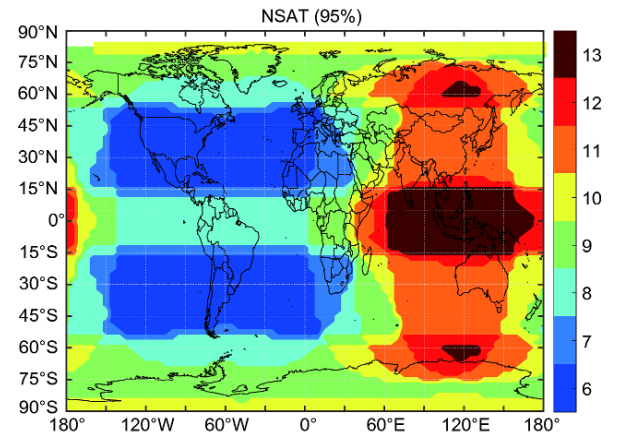
Figure 8 Distribution of visible satellites.
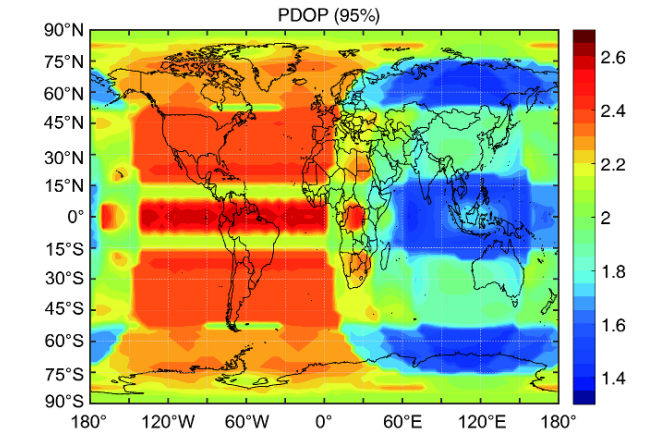
Figure 9 Distribution of PDOP.
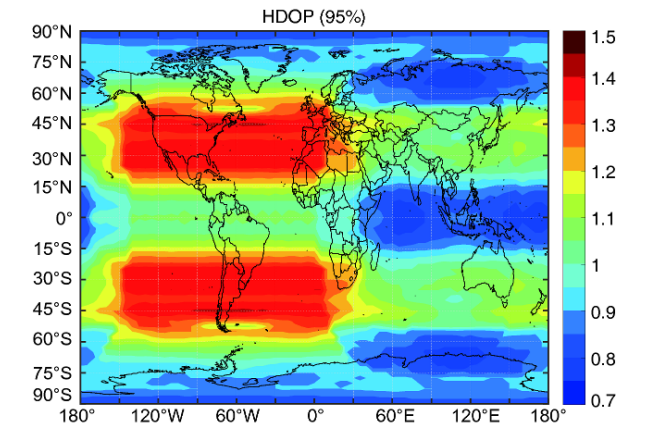
Figure 10 Distribution of HDOP.
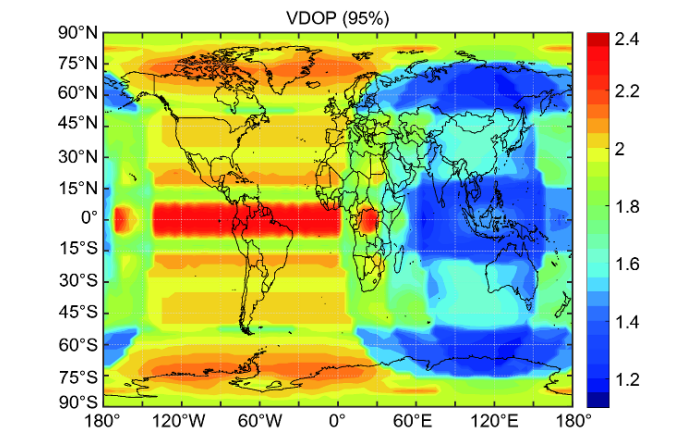
Figure 11 Distribution of VDOP.
We find that the number of visible satellites of BDS-3 inglobal scale is from 6 to 13;and there are at least 6 visiblesatellites within the area 150°W to 10°E and 15°S to 55°N.There are more than 11 visible satellites between 70°E to150°E and 75°N to 75°S;and more than 13 visible satellitesaround the area of the equatorial zone.
From the Figure 9,the PDOP value of BDS-3 is within 1.3to 2.7 in global scale.If the UERE is 1 m,the BDS-3 is ableto achieve 1.3 to 2.7 m positioning accuracy.
From the Figure 10,we find that the HDOP value of BDS-3 is within 0.7 to 1.5 in global scale.Thus,the horizontalpositioning accuracy provided by future BDS-3 will arrive at0.7 to 1.5 m if UERE is 1 m.
However,the UERE acquire in China territory could notrepresent the global signal quality of BDS-3,because thetracking stations for the determination of satellite orbit andsatellite clock offset are located in China at present.
05 Conclusions
This paper introduced the frequencies design of BDS-3 andthe payloads of the test satellites.Focused on the perfor-mance of BDS-3 from the perspective of the users,The SNRof the signals,multipath errors of pseudorange measure-ments and the signal-in-space quality,as well as the posi-tioning and timing accuracy are *** yzed.Finally,based on the tested signal qualities and the designed BDS-3 con-stellation,a simple prediction of the possible performance ofthe BDS-3 full constellation is carried out.The results can besummarized as below:
(1)Among the signals of BDS-3 test satellites,B1C signalhas the worst pseudorange measurement accuracy while B2a+b signal has the best;the pseudorange measurement accu-racy of Bs signal is worse than that of B2a+b signal,butbetter than that of B1C signal.
(2)The multipath effects of the pseudorange measure-ments of BDS-3 are less than that of BDS-2,and there is noobvious systematic errors associated with satellite elevationexist in the pseudorange measurements of BDS-3.Amongthe different signals of BDS-3,B2a+b signal has the stron-gest anti-multipath ability,while the B1C has the worst.
(3)In the aspects of signal-in-space quality and the timingaccuracy,the UERE values indicate that the user equivalentrange error of MEO satellites is better than that of IGSOsatellites;and the overall UERE is *** aller than 0.73 m.Thetiming accuracy is usually better than 10 ns and the worstaccuracy is about 21.9 ns.
(4)According to the simulation *** ysis of BDS-3 con-stellation,the number of visible satellites of BDS-3 in globalscale is about 6 to 13,the global PDOP value is between 1.3and 2.7,the HDOP value is between 0.7 and 1.5,and theVDOP value is between 1.1 and 2.4.When the UERE is 1 m,the global positioning accuracy is expected to achieve1.3�C2.7 m,the horizontal positioning accuracy is estimatedat 0.7�C1.5 m,and the elevation positioning accuracy is esti-mated at 1.1�C2.4 m.
It should be pointed out that the performance of BDS-3system will be further verified and *** yzed with the long-term operation and observation of the BDS-3 demonstrationsystem satellites and the launch of BDS-3 network satellites.Other performance,such as integrity(Xu et al.,2013;Yangand Xu,2016),reliability and robustness should also bestudied.
Acknowledgements This work was supported by National Key R&DProgram of China(Grant Nos.2016YFB0501700,2016YFB0501701)andNational Natural Science Foundation of China(Grant No.41374019).



